Atelier
How to Create a Living Landscape at Home
If you love keeping houseplants, you might be ready to attempt the next level of indoor gardening: maintaining a miniature rainforest under glass.
Text—Jade Prévost-Manuel
Photos—Indra Prasetyo
Indra Prasetyo dove into the art of terrarium building six years ago as a way of recreating his favourite ecosystems on a smaller scale.
In some of the glass tanks he keeps in his downtown Calgary apartment, poison dart frogs scramble across misted swaths of bromeliad- and orchid-peppered terrain. In others, he simulates habitats he remembers from a childhood spent around the higher-elevation rainforests of Indonesia. These are among the 30 terraria, or self-sustaining enclosed plant worlds, he’s carefully designed and crafted over the years.
Terraria range in complexity — a set-up can be as simple as filling an airtight glass jar with a few ferns, or as complicated as building a waterfall into a 300-gallon tank. But at their root, they’re glass-encased snapshots of life where nature lovers try to simulate processes that happen in the natural world.

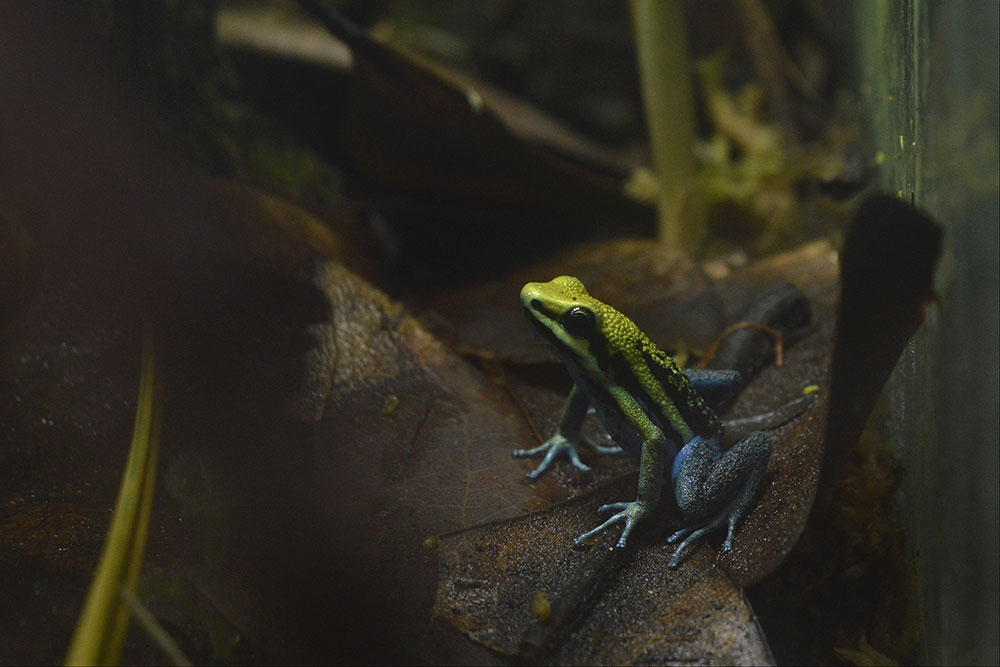
Sure, there are a lot of moving parts to consider when designing a self-sustaining ecosystem — you need to simulate precipitation, evaporation, and decomposition in a closed, artificial environment — but that shouldn’t deter newcomers to the hobby.
“There are a million different ways to grow terrariums, and there’s not really one correct way of doing it: there’s just the way that works best for you,” says Prasetyo.
Over the last decade, Toronto-based reptile enthusiast Mike Tytula has honed his own methodology for building vivaria — terrariumlike enclosures that also house animals.
—
Issue 11: New Times
What if changing the world begins with changing our relationship to time?
Order our Latest IssueThe reptile aficionado agrees that you don’t need to be an expert to start, and while many hobbyists are passionate about keeping animals, you don’t need them to create a happy environment for a lush variety of different plants.
“If you think it’s going to look perfect, it’s not,” he says. “It’s a lot of trial and error, but you’ve just got to be open to learning and taking in new information.”
In this DIY guide to building your own miniature plant world, BESIDE leans on the expertise of terraria veterans to teach readers how to build a bioactive, or self-sustaining, enclosure (with the option to add a frog or two).
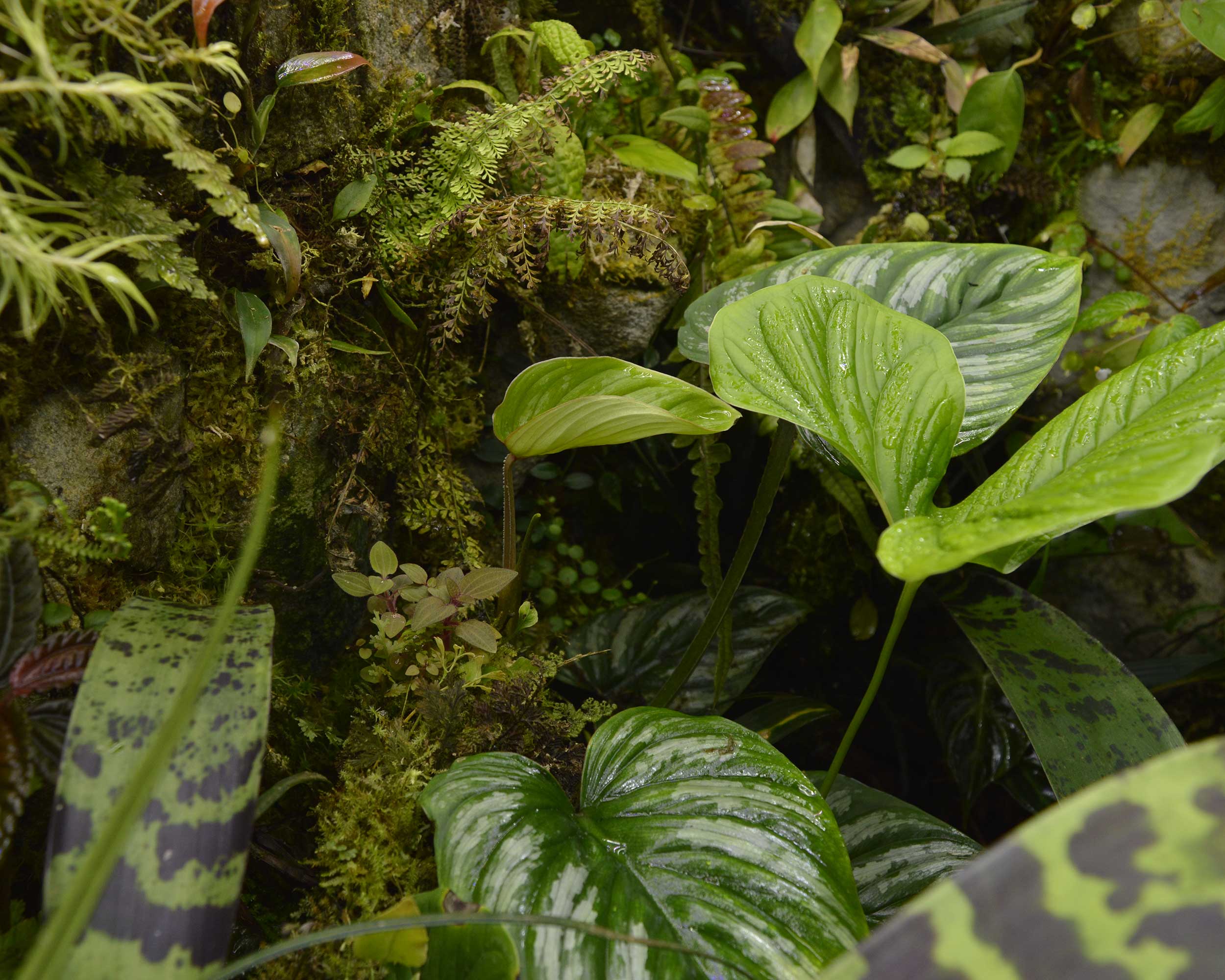
Designing a terrarium
____
– 1 –
Mood board your terrarium.
Photos and advice from other terrarium architects can help you narrow down a biotope, or habitat, to simulate, whether that be an arid desert or tropical rainforest. Building Northern-style habitats, like those found in Canada, can be a challenge. That’s because a lot of Northern plants require hibernation cycles to thrive — something that’s tough to simulate in a terrarium. For that reason, we’ll focus on building a tropical environment, a popular choice among hobbyists.
– 2 –
Pick a location.
For a tropical terrarium, you’ll want to pick an area that hovers around room temperature — if your terrarium gets too hot, you could lose the humidity your ecosystem relies on, causing it to dry out and your plants to wilt. Most hobbyists elect to keep their set-ups indoors.
– 3 –
Set a budget.
Plants can get expensive. Bioactive vivaria can cost a few hundred dollars or a few thousand to build, depending on the plants you’re investing in and the complexity and size of the build. By setting a budget early, you can discern ways to cut costs — you can get to know other terrarium hobbyists willing to share materials or sell plants at discounted rates. You can also save on your build by upcycling mesh from old windows and doors, buying tanks second-hand, and snapping up plants from the clearance rack at your local garden supply store.
– 4 –
Quarantine plants early.
Plants can harbour diseases and pests that compromise your build. To prevent either, de-pot your plants and strip away the old soil until you’re left with bare roots. Rinse and wipe down the plants thoroughly, and soak them in room temperature water for 10–15 minutes. Plant them in fresh pots with terrarium substrate in an enclosed, misted container (a large Tupperware should do). You’ll want to quarantine your plants for a period of one month before adding them to your terrarium.
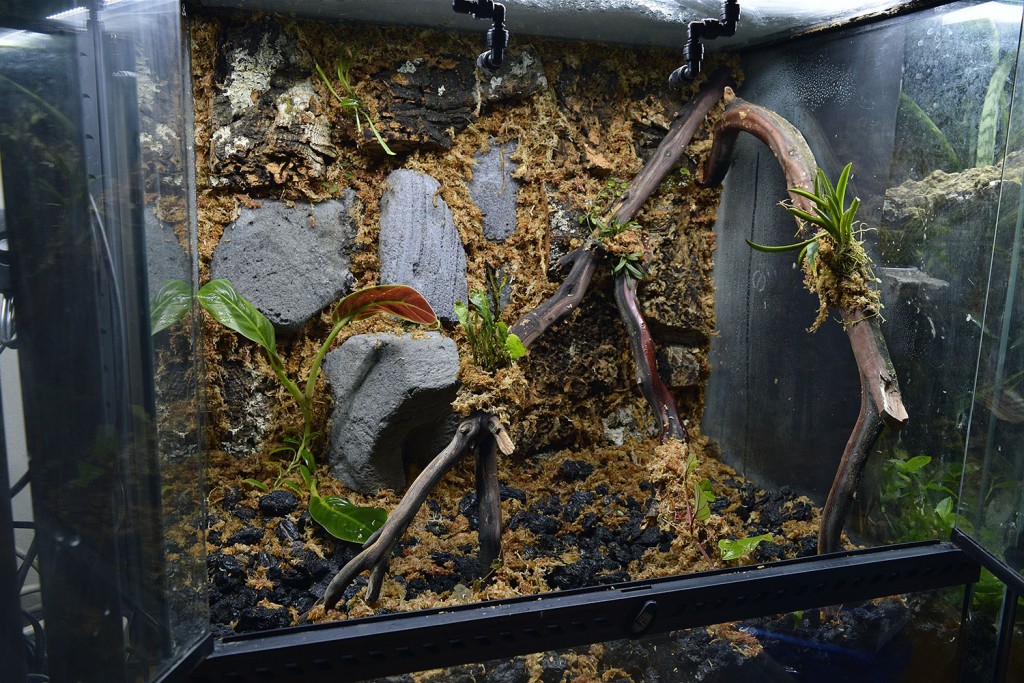
What you’ll need
____
- Glass tank with vents & lid
- Grow light
- Clay balls (or aquarium gravel)
- Premixed terrarium substrate
- Knitting mesh or mesh screen
- Leaf litter
- Décor elements
- Your plants of choice
- Springtails and isopods
- Cleaning vinegar and water mixture (ratio 1:1)
- Tank fan (recommended)
Building your terrarium
____
– 1 –
The container
When it comes to terrarium building, experts say glass is the way to go. That’s because it’s sturdy and easy to repair with silicone, whereas plastic and acrylic tanks can warp in high humidity.
Choose a waterproof tank based on the plants you want to keep. Wide tanks work better for plants that grow outward, whereas tall tanks better accommodate climbing plants like vines.
To create a bioactive terrarium, you’ll need a closed tank that keeps pests from coming in and decomposers from escaping. Terraria also require ventilation to thrive. Pick a tank with top or front vents that prevent stagnant air and mould. Tank fans can help and are relatively cheap — position a fan over a vent on the outside of your tank to keep your terrarium’s air fresh.
Wipe down the tank with cleaning vinegar and water before starting your build.
– 2 –
The drainage layer
Time to add a drainage layer. This layer isn’t essential, but it can keep habitats healthy long-term by soaking up moisture and preventing problems like root rot. Spread a two-inch layer of clay balls (you can also use aquarium gravel or pebbles from your own backyard, although these are heavier) across the bottom of the tank.
Next, measure, cut, and layer three squares of screen mesh to cover the rocks completely. The mesh separates the drainage layer from the soil, or substrate, layer, making drainage more effective.
– 3 –
The substrate layer
The substrate layer is where the magic happens — it’s the growing medium for your plants and the base for the ecosystem you’re about to create.
Substrate layers can get complicated, which is why buying a premixed substrate pack is the best way to go for beginners. Look out for mixtures that follow the ABG recipe, a classic mix used among hobbyists.
Pat down a one- to three-inch layer of substrate on top of your mesh. Scatter a generous layer of dead leaves (food for decomposers) across the top of the substrate. You can source these elements from your own backyard if you don’t spray pesticides — just toss these bits in the oven for 15 minutes at 121 °C [250 °F] to remove any lingering pests.
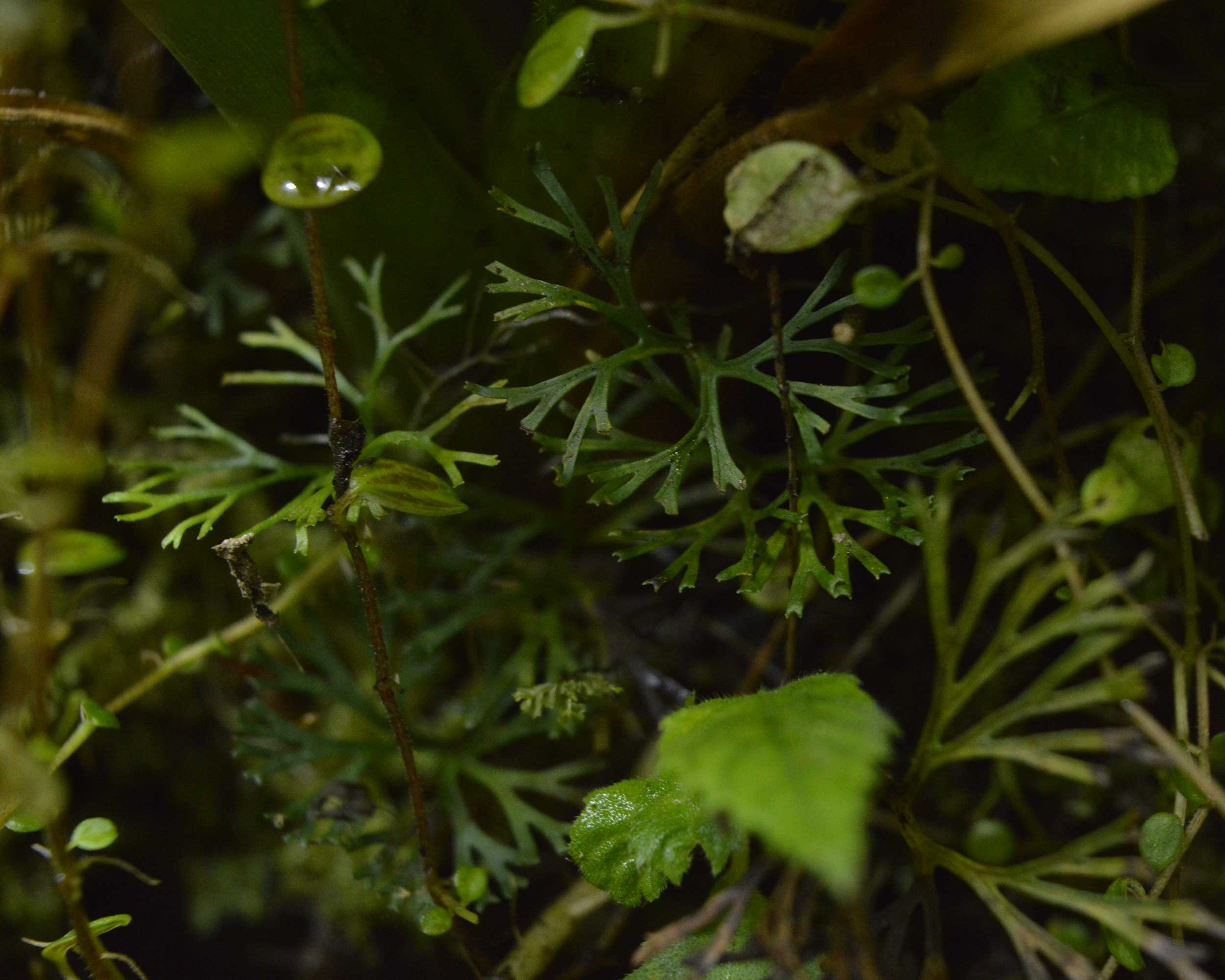
– 4 –
Adding life forms and decorating
Next, add in your plants. For tropical terraria, you’ll want to pick plants that can tolerate high humidity — bromeliads, vining plants, and ferns are a great place to start. Once those are nestled in the substrate, it’s time to bring in the cleanup crew.
To make your terrarium self-sustaining, you’ll have to add organisms that decompose dead organic matter, add nutrients, and remove pests. Isopods (pill bugs) and springtails (an insectlike critter) are your best bet. Add branches, logs, coconut shells, and other decor elements to personalize the tank.
– 5 –
The final touches
Lastly, you’ll want to add a grow light above the tank (under-cabinet or LED lights work) to regulate tank temperature. Lights with a colour temperature between 5,000 and 6,500 Kelvin generally provide the nicest lighting.
If you’re keen to keep creatures, thumbnail dart frogs (Ranitomeya) are great starter pets for new vivarium builders. These critters require a 12 x 12 x 18 tank, ample leaf litter, and hiding spots to thrive. Frogs, however, will add to the budget: between $40 and $80 per frog, depending on the species. You can start with just one.
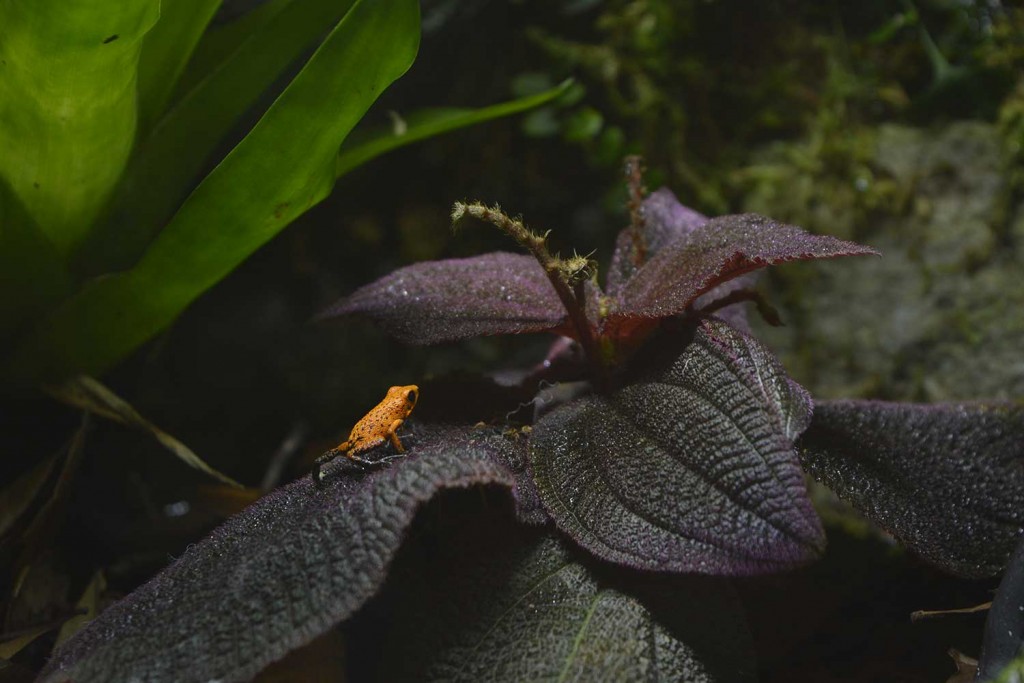
Looking to dive deeper into terrarium building?
Here’s BESIDE’s recommended reading and viewing list:
How to Setup a Bioactive Enclosure with, or without, animals
Vivariums – Everything You Need to Know (From the Ground Up)
Jade Prévost-Manuel is a Canadian journalist who has reported for publications like SUSTAIN Magazine, Outpost Magazine, and CBC News. When she’s not telling stories on land, she’s exploring life below the ocean’s surface.
Never Miss Another Issue
Two issues per year
25% OFF previous issues
Free Shipping in Canada